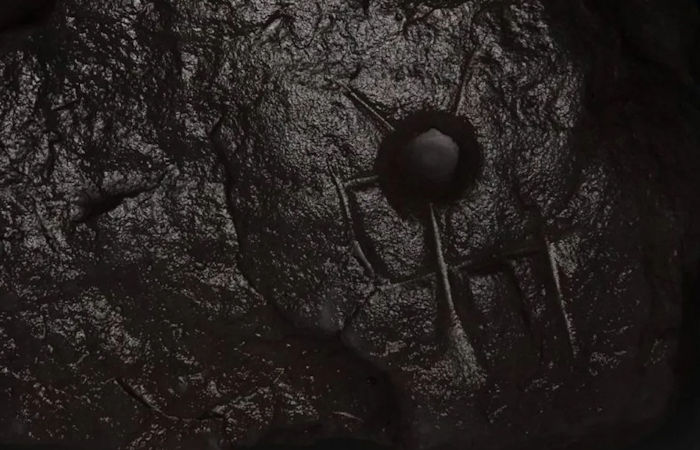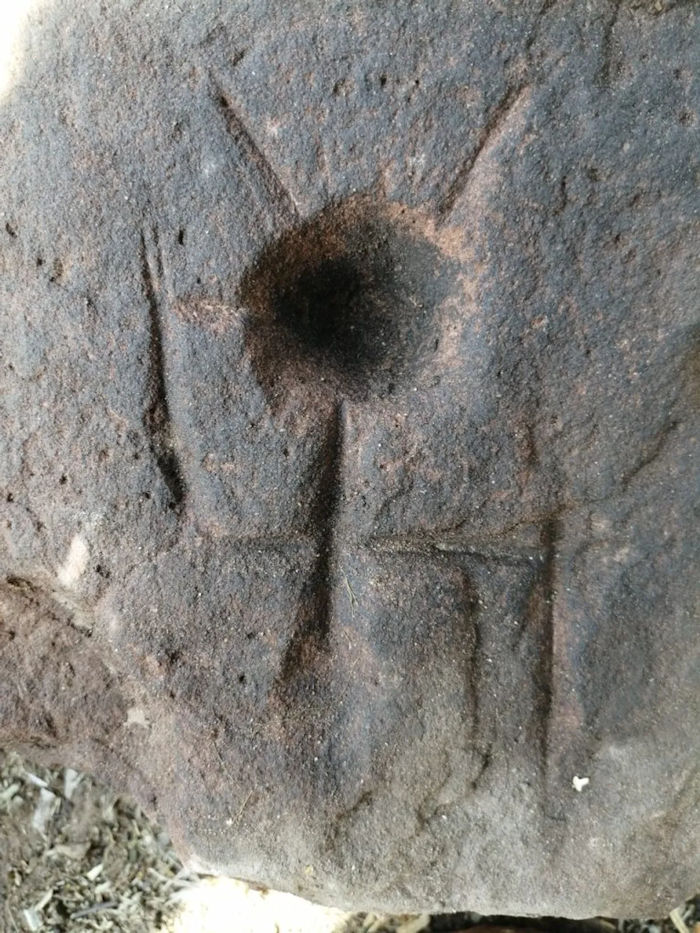Jan Bartek – AncientPages.com – Archaeologists are appealing to the public for help with an unusual carving they unearthed at Nesscliffe Hill, UK, in 2022.
Paul Reilly, a visiting fellow in archaeology at the University of Southampton, and Gary Lock, emeritus professor of archaeology at the University of Oxford, returned to the site last summer to resume explorations that began in 2019 and discovered an unusually carved red sandstone stone which has left them puzzled.

Nesscliffe find. It may represent a horned being wielding a weapon. Image credit: Shropshire Council.
The stone, now known as the Nessglyph, has a circular cup shape and is marked with straight lines carved with a metal implement, and was found in a spot that had been explored in the 1950s and was backfilled.
The Shropshire Council-managed site is an impressive Iron Age hillfort, but also with later Roman occupation and has already been subject of excavations that have revealed some interesting finds.
“The circular cup shape and the straight lines are indicative of two different types of technology, grinding and carving.
“We can speculate that the Nessglyph is figurative, with the cupmark being the head. It has two long horns and two small horns, a central body line and two arms, one held up and the other down, the upward one showing a possible hand holding a pipe or a weapon.
“It is difficult to find Iron Age parallels, but the carving has similarities with Late Bronze Age carvings of figures in horned helmets. It is also worth noting that Nesscliffe lies within the putative territory of the Cornovii, a name that has been suggested to reference to the ‘horned ones’. There is the possibility of a connection to a horned deity cult in the Roman army as depicted at several military sites across Britain.
“Because the Nessglyph was not found in a secure context but in the backfill of a 1950s excavation trench within the guard chamber of the inturned entrance, it is more difficult to identify, and we are inviting people to help us solve the puzzle, or tell us if they have seen other similar carvings,” Dr, Reilly said.
“This is an opportunity for people with an interest in our history to get involved and help solve the mystery of the Nessglyph.
Nesscliffe Hill Fort has been giving up interesting finds for a number of years and it is fascinating learning about our county’s rich history, especially when it leads to a puzzle such as this,” Rob Gittins, Shropshire Council’s Cabinet member for culture and digital, said.

Nesscliffe Hills and the Cliffe Countryside Heritage Site, managed by Shropshire Council, covers two wooded hills and a heather-covered ridge and gives expansive views over the Shropshire countryside and Welsh hills.
Nesscliffe Camp is a protected Historic England Scheduled Monument of national importance.
In 2019 details of the earth and stone rampart surrounding the site were explored, together with a monumental stone entrance with guard chambers. The entrance was further explored in 2021, together with the opening of new trenches in the hillfort’s interior, where a geophysical survey had indicated houses.
The Nessglyph was discovered in 2022 when the team resumed its exploration.
Anyone with information or knowledge to help solve the puzzle should contact Paul Reilly at [email protected] or Gary Lock at [email protected]
Written by Jan Bartek – AncientPages.com Staff Writer





